Copper dishes: the subtleties of care, benefits and harms
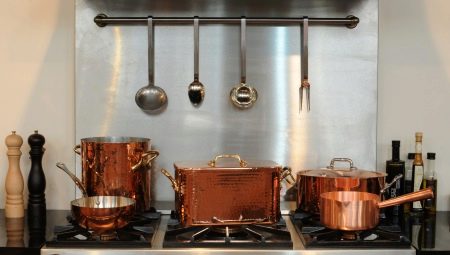
Kitchenware today is made from different materials. There are items made from raw materials of the last generation, as well as products that have been in use by humans for more than one century. Copper utensils should be included in the latter category.
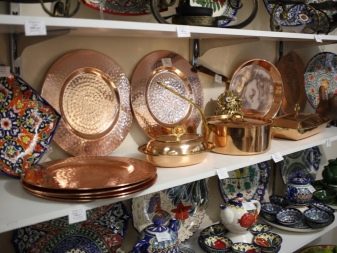
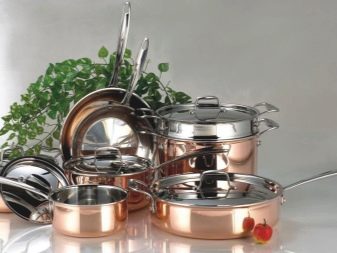
Peculiarities
The quality and appearance of kitchen utensils, which are actively used in everyday life or serve as a decor item in the room, are of great importance for every housewife. Such an attitude towards such objects in the home determines a special approach to the choice of products, in particular, to the material from which the dishes will be made. Since the appearance and durability of the purchased household items largely depends on the characteristics of the raw materials.
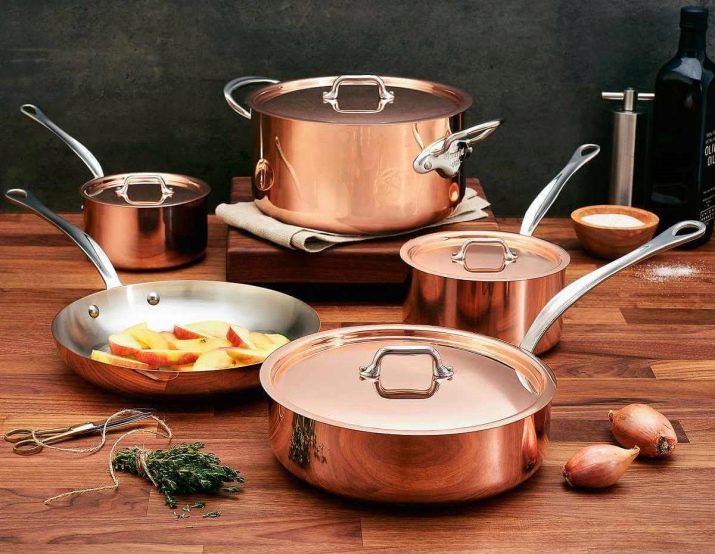
When quality becomes the main aspect in the selection process, metal cookware will take the lead, especially copper.
This is due to the fact that the alloy lends itself well to processing, and this allows craftsmen to make copper utensils of any shape and size. In addition, copper items will successfully fit into any kitchen interior in a residential area or in a public institution. Copper utensils can be of several shades. The following color variations are common today:
- pink and red dishes, which are equally well suited for daily use and room decoration;
- yellow and orange products - imitating "semi-antique" products.
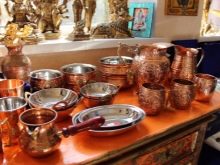
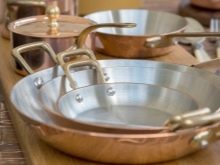
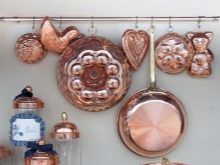
Such a variety of colors is in demand by many interior designers, as well as by chefs, for whom a harmonious combination of dishes with the external design of the working area in the kitchen is important. Another feature of copper products is their attractive appearance. even with the simplest forms and the absence of additional decor. Thanks to such qualities, for many connoisseurs of beautiful things, the high cost of copper kitchen utensils is fully justified. Today, manufacturers offer cooks and housewives not only pots made of this metal, since there are copper fondue bowls, saucepans and turks on sale, as well as teapots, pans and much more.

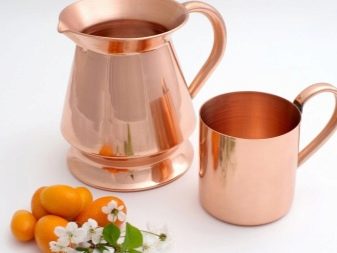
According to most connoisseurs of aromatic coffee drinks, it is in the copper turk that the best coffee can be prepared.
Desserts and savory sauces are endowed with special taste. As practice shows, most of the "capricious" in processing products can be cooked in pots and pans made of copper. In dishes from this metal, the most delicate and fluffy whipped proteins are formed.
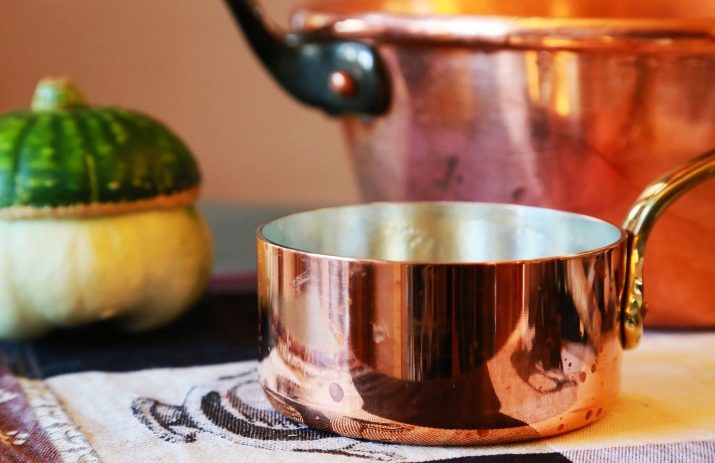
There are no restrictions on the use of certain ingredients and products with copper utensils, since modern products inside have a special coating of stainless steel or tinned tin, and manufacturers also use nickel in their work. This specificity of manufacturing is due to the peculiarities of copper to react with an acidic and slightly acidic environment, which is fraught with the formation of compounds harmful to human health.
In addition to harm to the body, such food can change its organoleptic qualities not for the better.
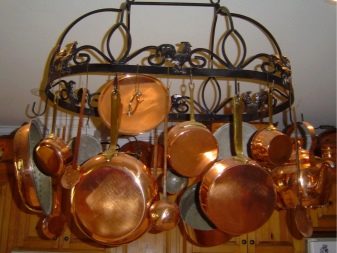
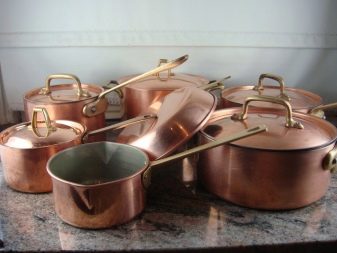
Considering the individual properties of copper, it is also worth noting that with direct contact of metal with food at high temperatures, food loses most of the ascorbic acidso plating a different alloy on the inside is a must to keep the good. Also, under the influence of high humidity, the metal is oxidized, which leads to the formation of a patina.
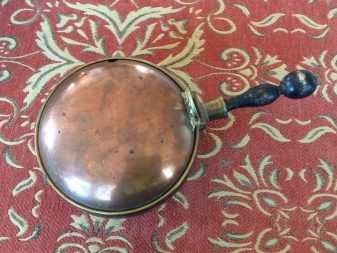
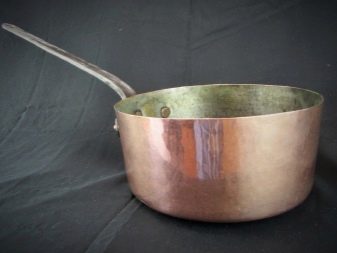
This point should be taken into account when caring for dishes.
Advantages and disadvantages
Since the use of copper utensils in the kitchen is in demand in many countries, in addition, utensils made of yellow and red metal for cooking have been used in everyday life for more than one century, chefs and housewives note the pros and cons of such products. So, the advantages of copper cookware include the following.
- The raw materials are distinguished by their increased sensitivity to temperature values. It is noted that the thermal conductivity of metal is 2 times higher than that of aluminum, and also 10 times higher than that of stainless steel. Such characteristics determine its rapid heating, if necessary, cooling. Therefore, as the main advantage, it is worth highlighting the ability to control all stages of cooking in copper containers.
- The heat transfer of copper excludes food from burning during the heat treatment, you can also be sure that the dish will be exposed to uniform temperatures from all sides.
- Antibacterial properties are inherent in the metal. For example, using copper utensils reduces the likelihood of contamination with harmful microbes, including salmonellosis and E. coli.
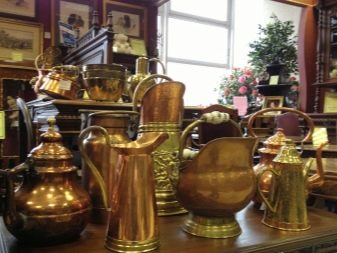
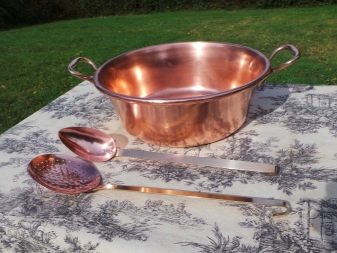
Among the disadvantages of such products for cooking, it is worth highlighting the following.
- Cookware without treated inner surfaces can be harmful to human health. This is especially true of the release of free radicals when interacting with vitamin C.
- Also, among the minuses, it is necessary to highlight the poor resistance of the metal to high air humidity. In the light of constant contact with moisture, products made of this metal can become covered with a green coating, which will adversely affect the external characteristics of the products, in addition, make it impossible to use and cook food in it.
- The disadvantages of copper cookware include its high cost in comparison with similar products made of stainless steel and other alloys.
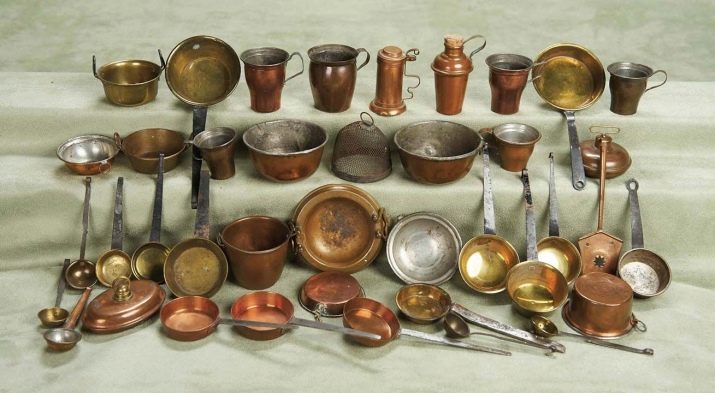
This is due to the poor removal of metal from the body, as a result of which serious poisoning may occur.
Popular brands
In light of the demand for such products for decoration and household use, many companies are engaged in the manufacture of copper products. Among the most popular domestic and foreign brands are the following.
- De Buyer. A French company that specializes in the production of kitchen products. Today, copper products made in France are imported all over the world. Its main advantage is considered to be high quality, as well as the introduction into production of new developments that have a positive effect on food preparation.
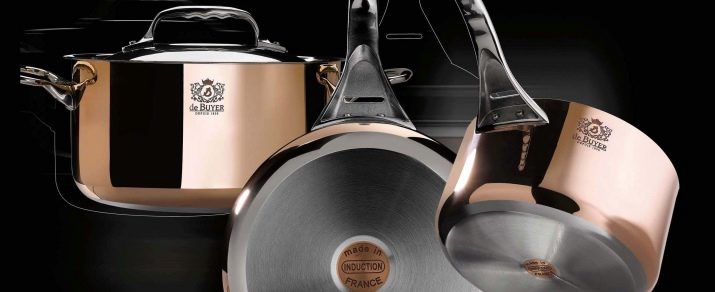
- TM MACO. An equally popular company that produces copper cookware. The products of this manufacturer are good for their affordable cost, in light of which they are in demand not only among housewives who appreciate beautiful saucepans, pots and pans, but also among the owners of restaurants and cafes.
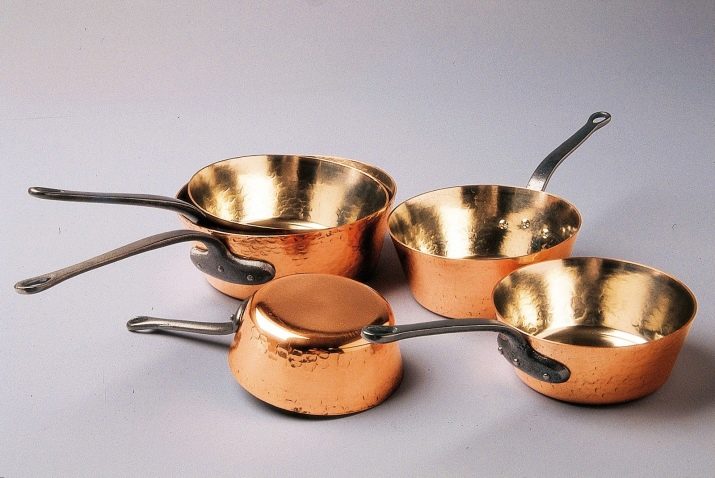
- Supra. This large concern includes the oldest family factory, which has been producing copper dishes for quite some time. That is why the products from the Japanese brand stand out for their design, large assortment range, as well as the preservation of centuries-old production traditions.
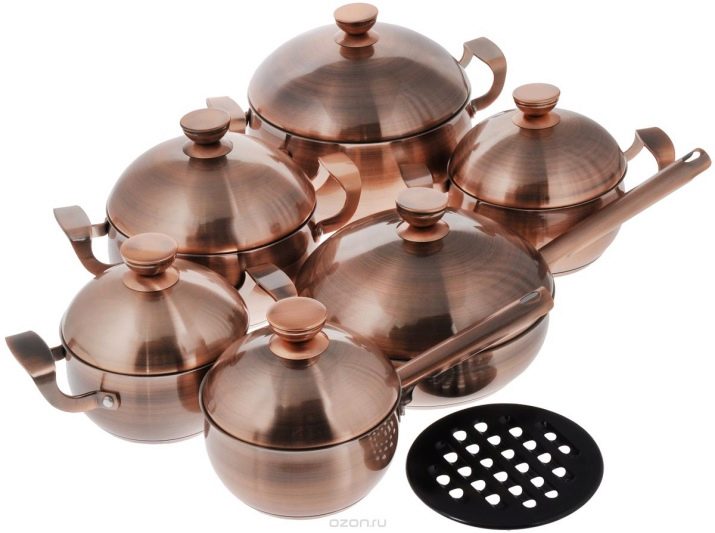
- TVS. Italy did not stand aside in terms of the manufacture of copper products for work in the kitchen. Today, the brand's products are successfully sold all over the world, Russia is no exception. Fans of beautiful dishes from the Italian manufacturer will be able to find them on the shelves of the largest hypermarkets in the country.
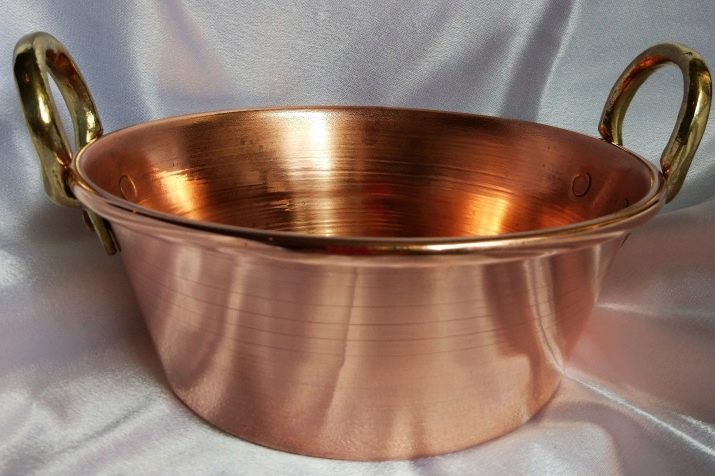
- Basilico. A sought-after brand, whose products are in the middle price segment, but stand out for their proven quality.
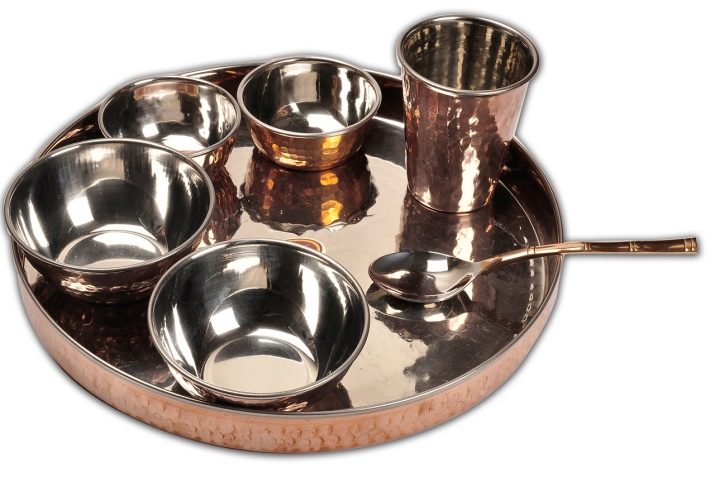
- Bioflon. The company, founded in Portugal, today its products are successfully sold on the Russian market. Copper cookware of this manufacturer is suitable for any kitchen and stove, in the light of its design, it is used to decorate the interiors of elite cafes.
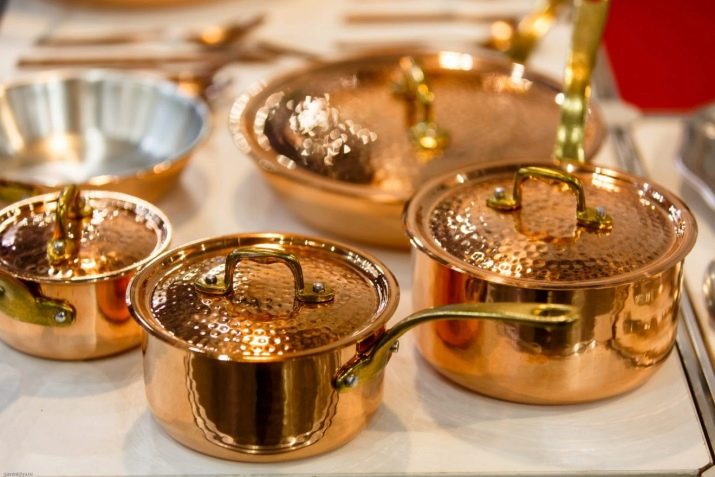
- Ruffoni. An Italian brand that manufactures and markets copper cookware. The assortment of the company includes products that can be used as decor items in restaurants, as well as utensils for cooking. All products undergo quality control, therefore they are absolutely safe for human health.
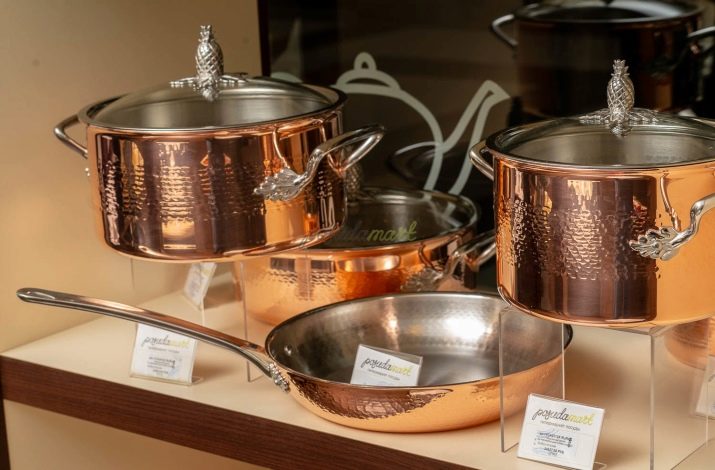
In addition to the above brands, Asian, Indian and Turkish companies are engaged in the manufacture of copper products, which offer consumers elite class products, as well as options that have a budgetary cost.
How to choose?
Regardless of whether the dishes will be used for their intended purpose or as an interior item, when buying, you should adhere to the following recommendations.
- Copper products should only be purchased from trusted manufacturers. In this case, you should not chase cheap goods, since such a cost is most likely due to the use of low-quality raw materials in the production process. Usually cheap pots, Turks and other utensils are made not of copper, but of alloys of unknown origin, which can be fraught with serious problems when used.
- Often, under the guise of copper utensils, unscrupulous distributors offer goods with copper plating. To distinguish one product from another, it is worth scratching it a little to make sure that the metal used is intact.
- Embossed or forged products will last much longer.
- Copper is several times heavier than stainless steel and other alloys, so you can check the dishes you like by simply picking them up.
- The leading positions on the market in terms of the quality of tableware are held by trademarks from Italy, Iran and India.
- The inner coating must be selected based on the further use of the dishes. So, steel or nickel is better for frying, tin for cooking. In general, copper cookware is universal, but there may be some limitations in terms of use with different types of hobs, for example, with induction hobs.
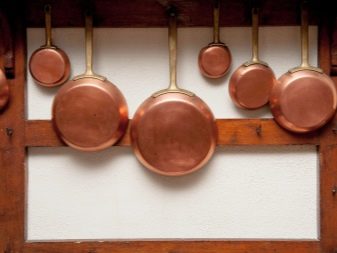
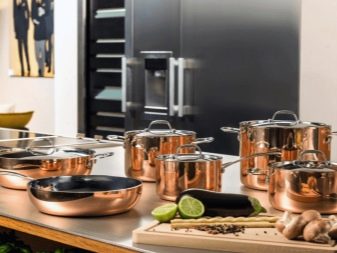
Storage and care
For copper products, the conditions in which they will be further operated and stored will determine their service life.
Careless or illiterate handling is fraught with the formation of scratches, plaque or patina on the metal surface.
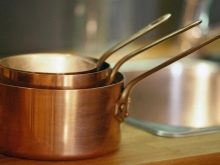
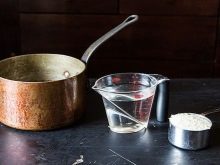
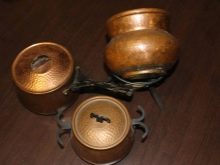
It is dangerous to use dishes with plaque. Therefore, housewives and cooks who have similar cooking utensils in their arsenal should adhere to the basic care recommendations.
- Regardless of the size of the products and the degree of their contamination, they need to be washed only by hand without the use of aggressive chemical compounds and dishwashers. It is also forbidden to use chlorine and compounds based on acidic media during the cleaning process.
- For the care of copper products, it would be more correct to use flour and salt, which are good means for cleaning surfaces from various contaminants. As an alternative to bulk products, you can select tomato paste, freshly squeezed lemon juice. Any abrasive compounds and sponges cannot be used.
- If the container is dry, it is forbidden to pour boiling water and just very hot liquid into it.
- To avoid damage to the dishes, it is not recommended to put them on fire or in an empty oven.
- All cooking processes that require mixing the ingredients in a container must be carried out with wooden spoons, slotted spoon and other equipment. You can also use silicone fixtures.
- To maintain an attractive appearance of the dishes, you can treat the metal surface with a special polish that has antioxidant properties.
How to clean copper utensils, see below.








